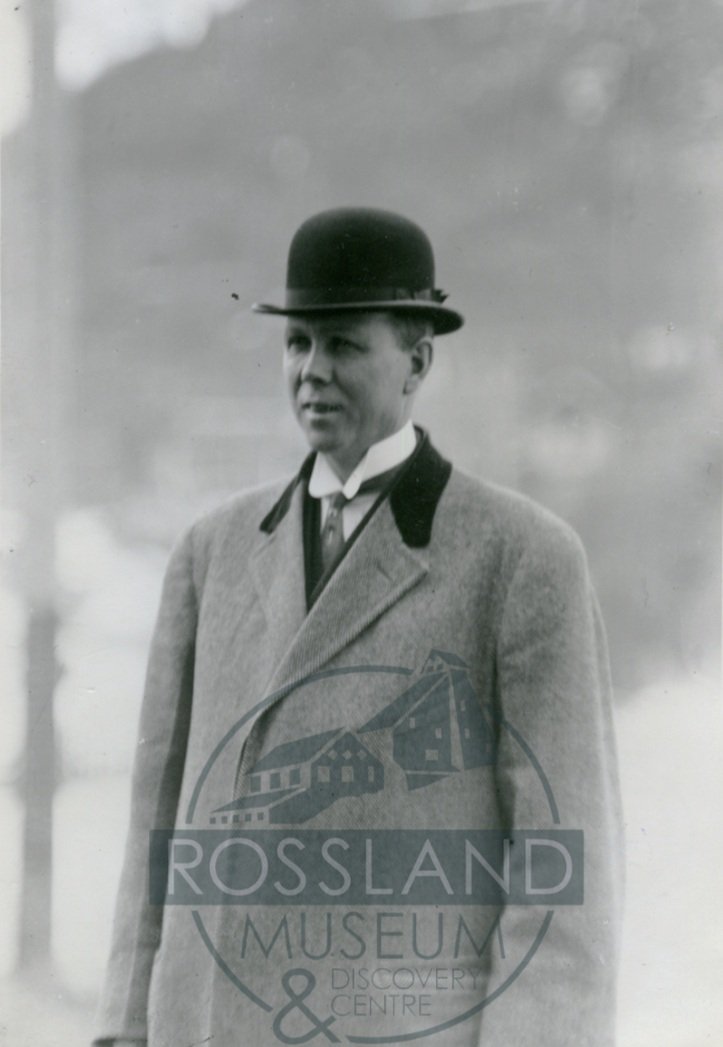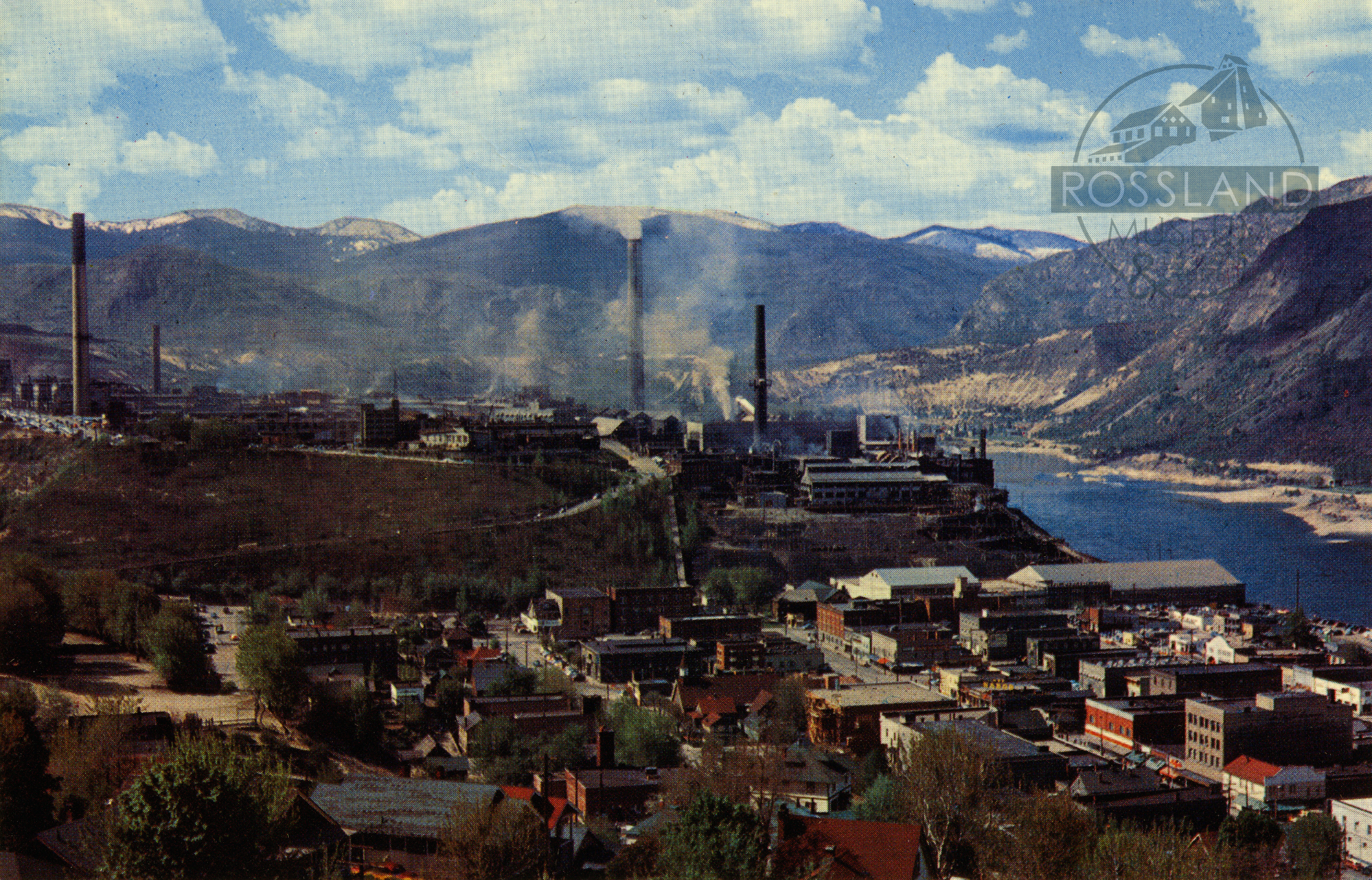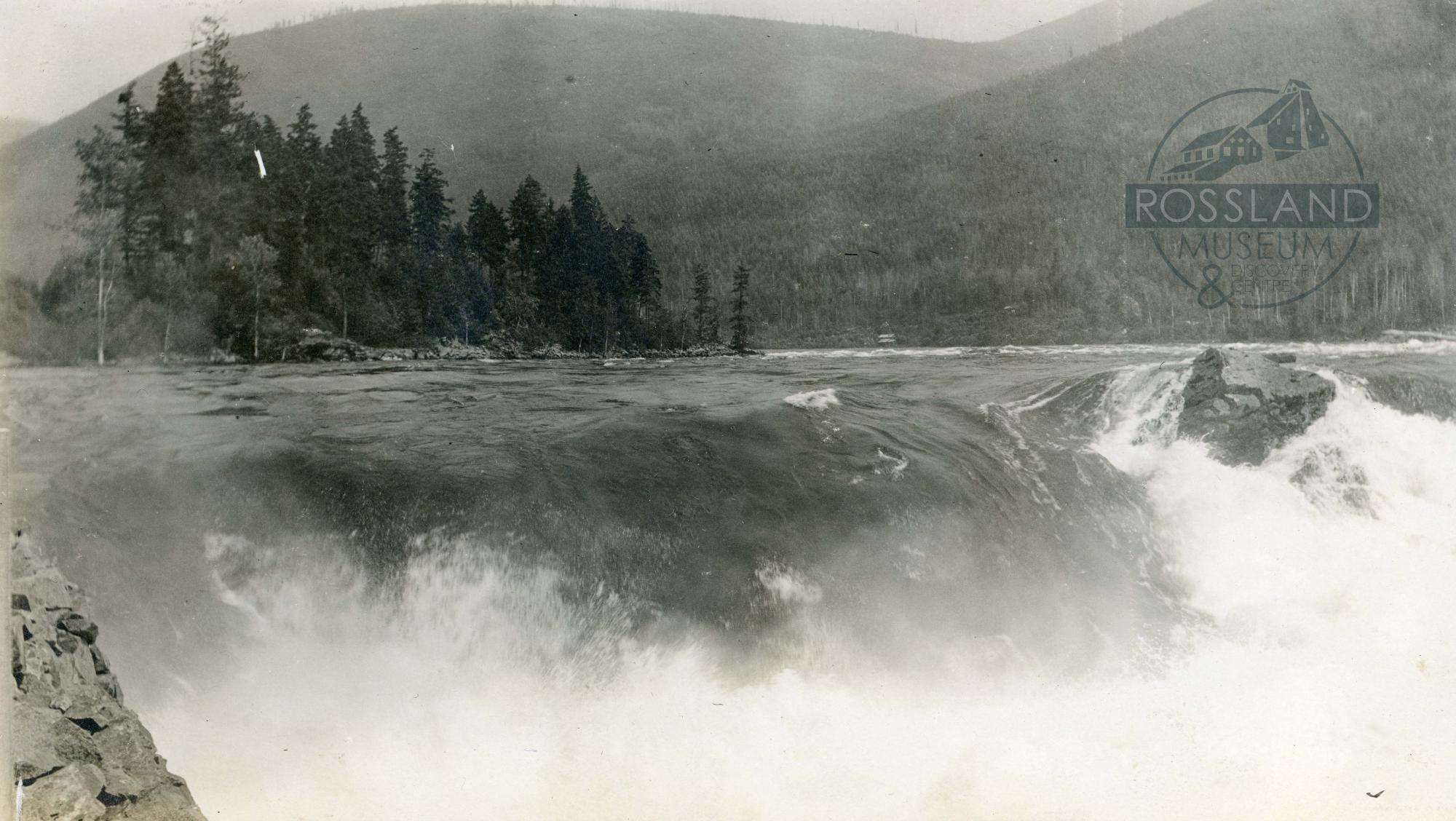West Kootenay Power: Through the Ages
The West Kootenay Power & Light Company (WKPL) has been influential in the growth and development of Rossland and the surrounding communities. Rossland’s golden boom town years and later skiing fame would not have been possible if not for the electricity services and breakthroughs provided by the WKPL.
Key Figures
Sir Charles Ross, 9th Baronet of Balnagown
By permission of the Tain & District Museum & Clan Ross Centre, 638.5: Sir Charles Ross.
Charles Ross (1872-1942) was the founder of the West Kootenay Power & Light company. Ross was a Scottish noble and educated at the prestigious Eton College and Cambridge University.
Ross arrived in Rossland between 1895-1896 and became involved in the Centre Star Mine. He formed West Kootenay Power & Light to supply power to the Centre Star Mine, but soon received a charter to supply electricity to the entire West Kootenay region. Ross named sections of the Kootenay River (Bonnington and Corra Linn) after waterfalls in his native Scotland. He was directly involved in the construction of the Lower Bonnington Dam and the power line to Rossland, frequently visiting the site.
Ross is more widely-known for inventing the infamous Ross rifle, used by the Canadian Expeditionary Force during the First World War. Although an excellent hunting rifle, it was unsuitable for the hardship of trench warfare and frequently jammed.
L. A. Campbell
Lorne Argyle Campbell (1871-1947) was not just a staple of West Kootenay Power & Light, but Rossland itself. Originally from Perth, Ontario, Campbell started his career at the Canadian General Electric Company and became the company’s Chief Engineer at the age of 21. In 1898, his career took him to Rossland, securing the role of General Manager of West Kootenay Power & Light. As the company’s leader, Campbell revolutionised energy production in the West Kootenays and oversaw one of the most significant power production programs in Canada. At the time of his death on April 29, 1947, Campbell had led WKPL for 49 years. He was much beloved in Rossland and following the announcement of his death, local businesses were shuttered in his honour.
Campbell’s ambition led him to a secondary career in provincial politics. In 1912, he was elected to the Legislature Assembly of BC as a member of the Conservative Party. Campbell was appointed to the cabinet in 1916 as the Minister of Mines, serving in that capacity until 1920.
J. D. McDonald
John Dingwall McDonald (1874-1944) was the General Superintendent of West Kootenay Power & Light. Born in Woodstock, Ontario, McDonald received a position at WKPL in 1898 and worked for the company until his retirement in 1942. During his time at WKPL, McDonald was instrumental in some of the company’s biggest projects, such as the construction of the hydro-electric plants. Upon his death in 1944, McDonald’s longtime colleague, Lorne Campbell, told the Rossland Miner that “[McDonald] had been intimately associated with power development of the Kootenay River since its inception . . . his death severs a link with the pioneer days.”
McDonald’s son, John David “Jack” McDonald, was one of Rossland’s early historians and founders of the Rossland Historical Museum. The Museum’s J.D. McDonald Hall is named after “Jack.”
Pre-Dam Years
The WKPL built on rivers in the West Kootenays that were originally used by Indigenous peoples, such as the Sinixt, Ktunaxa, Secwépemc, and Sylix Nations. The Bonnington Falls along the Kootenay River was an important salmon fishery for Sinixt First Nations peoples. Sites along the Kootenay, Columbia, Pend D'Oreille, and Slocan Rivers also hold importance for the Sinixt.
Photo 2337.0141: The Kootenay River rapids circa 1899.
1897:
WKPL Incorporates
In 1897, the West Kootenay Power & Light Company incorporates with the aim to provide power to the Rossland Mines. This goal quickly expands to include the entire West Kootenay area. Sir Charles Ross is the founder and one of the primary owners of the company, and Lorne Campbell is the first General Manager.
Photo 2313.0158: Lorne Campbell in his office in Rossland, taken in March 1911.
1897-1898:
Plant No. 1 is Built
The Lower Bonnington plant, known as Plant No. 1, is built on the Kootenay River. Sir Ross chooses the name ‘Bonnington’ for the falls and dam after a place he enjoyed visiting in the Scottish countryside as a younger man. He would choose many dam names this way.
Photo 2337.0150: The Lower Bonnington Falls Dam, c.1900.
1898:
Power To Rossland
On July 14th, 1898, the first light supplied by WKPL illuminates Rossland on the south side of Columbia Avenue. This was an engineering feat for the time, with 51.5 kilometres (32 miles) of powerline having been built between Rossland and Bonnington. It is believed that this was the longest powerline to date in B.C., and possibly even North America! This monumental task was accomplished in a little over a year.
Photo 2318.0047: West Kootenay Power & Light Company workers raising a power pole along the Bonnington to Rossland route in 1897.
1906-7 :
No. 2 Plant is Built
To keep up with increasing energy demands, a second dam was built on the Kootenay River above the previous No. 1 Plant on the Upper Bonnington Falls. This dam is expanded in 1914 and again in 1916.
Photo 2338.0062: The No. 2, or Upper Bonnington Plant during its construction, taken in 1906.
1906 - 1907:
Boundary Expansion
With the aim of large-scale expansion, West Kootenay Power buys the charter of the nearby South Kootenay Power Company. They expand into the Boundary County, supplying their mines with power. In May 1907, the competing Cascade Power Company sells its assets to WKP&L, giving them ownership of the Cascade Dam on the Kettle River.
Photo 2318.0022: The Cascade Dam during its operation by WKPL, taken in 1920.
1916:
CM&S Partnership
Anticipating growing energy demands, especially with the First World War bringing large zinc contracts, the Consolidated Mining & Smelting Company (CM&S) acquires the West Kootenay Power & Light Company as a wholly-owned subsidiary. CM&S will later change its name to Cominco and then to Teck (Teck Trail Operations in Trail, BC).
Photo 2318.0171: The CM&S smelting operations in Trail, BC taken July 1st, 1913.
The Packard Truck
The Packard Truck seen on the grounds of the Rossland Museum & Discovery Centre was donated by the West Kootenay Power & Light Company in 1976. WKPL bought the truck in 1917 and used it for multiple purposes up until its donation to the museum. The Packard truck was a product of the early twentieth century. Capable of carrying great weights over less than ideal road conditions, Packard trucks were even used by the U.S. during World War I.
1932:
Plant No. 4 is Built
With ever-expanding CM&S Operations, a fourth dam called Corra Linn is built nine miles downstream from Nelson on the Kootenay River. This plant includes 14 flow gates, which allow for increased and controlled water storage in Kootenay Lake. This allows energy production to become fixed as opposed to the previous operating style in which electricity production was dependent on the natural flow of the river.
Photo 2341.0111: Plant No. 4, or Corra Linn Dam, in operation in August 1932.
1948:
The Trail Flood
An unusually high amount of rain leads to massive floods throughout the Columbia Basin. Trail faces some of the worst flooding in the West Kootenays, with estimated damage worth $362,890. The International Kootenay Lake Board of Control worries that discharge from the Corra Linn dam is responsible for raising water levels and prompting the flood.
Photo 2318.0102: Trail during the 1948 flood.
1951:
New Engineering Feats
After WWII, CM&S wants to connect their new Sullivan Mine operations in Kimberley to the electricity produced at the South Slocan Dam. However, the connecting powerline needs to cross Kootenay Lake. West Kootenay Power’s lines once again make history, completing the longest powerline span in the world at that time, measuring 3.4 kilometres (2 miles). This connected the route across Kootenay Lake.
This drawing appeared in the March 1952 edition of Cominco Magazine showing the proposed design for the span, in particular the plan for the final power pole before the lake.
1954:
The Waneta Plant
Experiencing a post-war boom, a private CM&S contractor is hired to build a dam on the Pend D’Orielle River, named the Waneta Dam. This dam was first planned in the 1920s with the goal to begin construction in the 1930s. Powerlines were even built to the planned site. However, the impact of the Great Depression led to the project being abandoned until the 1950s.
This photo, which was published in the April 1954 edition of Cominco Magazine shows the Waneta Dam shortly after becoming operational.
1964:
The Columbia River Treaty
Prompted by the disastrous flooding in 1948, the Columbia River Treaty was created to enable stronger communication, cooperation, and protection between dam companies in Canada and the U.S. The treaty had Canada guarantee better flood and water control in exchange for a 69.6 million dollar (CAD) payment from the U.S. The U.S. in turn was to reimburse Canada for the subsequent 60 years of flood assurance they would receive. The treaty was signed and ratified in 1964. The treaty should be renegotiated and renewed in September 2024.
Photo 2336.0064: Bonnington Falls Dam.
1987 Onwards
Ownership of WKPL changed to the private, U.S.-based company Utilicorp in 1987. Ownership changed again in 2004, with FortisBC buying the business. Fortis has remained the operator of the former WKPL dams ever since.
Photo 2306.0227: Photo overlooking Trail, showing Cominco operations, unknown date.
Impacts on Indigenous Communities
While hydroelectricity has been integral to the development of today’s communities in the West Kootenays, their impact on the indigenous communities of the area, including significantly the Sinixt Nation, must be noted.
The construction of the company’s dams in the West Kootenays is one of the main reasons for the displacement of the Sinixt peoples, who had permanent communities in southern British Columbia and Northern Washington state. With the introduction of prospectors, mines, and boomtowns, intolerance for Indigenous peoples grew, making settlements near these boomtowns less feasible. Moreover, the extensive damming of the Kootenay River among other rivers changed the local environment. For example, they notably destroyed many Kokanee Salmon runs in use by the Sinixt. Since the early 1900s, The Sinixt peoples increasingly utilized their southern reaches of territory in Washington State over those in B.C. This resulted in less permanent Sinixt settlements north of the border. Around the time the Canadian government declared the Sinixt Nation extinct in 1956, over 250 Sinixt people were listed on the census for the Colville reservation.
Moreover, a vast amount of important cultural Sinixt sites were destroyed by the flooding caused by dam building, with a notably large impact on burial sites. In Canada, only a few Sinixt grave sites remain undamaged by the dams, located in the South Slocan and in Vallican. This area in general remains the final small pocket of undisturbed Sinixt territory within B.C.
In 1956, due to what they claimed was a lack of tangible heritage sites and physical presence, the Canadian government declared the Sinixt Nation extinct, a completely false statement. Furthermore, despite numerous indigenous groups existing within the Columbia Basin, notably the Sinixt, Sepwepemc, Kutenai, and Okanagan Nation Alliance, it took until 2019 for any of these groups to gain any recognition within the Columbia River Treaty. They now hold observer status.
Despite the struggles that dimensioned the preservation of the Sinixt’s cultural heritage and decreased their physical presence, it is important to recognize that they are still here. The Nation still exists and should be acknowledged by the federal government for not only their historical presence, but for their ongoing existence within the region.
The Sinixt territory is shown on this map (zoom in or click full screen for further detail).
For more information on the history and resurgence of the Sinixt and the Autonomous Sinixt, please visit Sinixt.org
Continue the Outdoor Tour:
Continue the Indoor Tour:
Contribute your own memories/experiences of the Columbia River, The Trail Flood, and/or Power Generation in Rossland:
The form below will email us your message. If you prefer to speak to us directly or have other questions or comments about this page, please call (250) 362-7722 or email the archives directly at archives @rosslandmuseum.ca
























